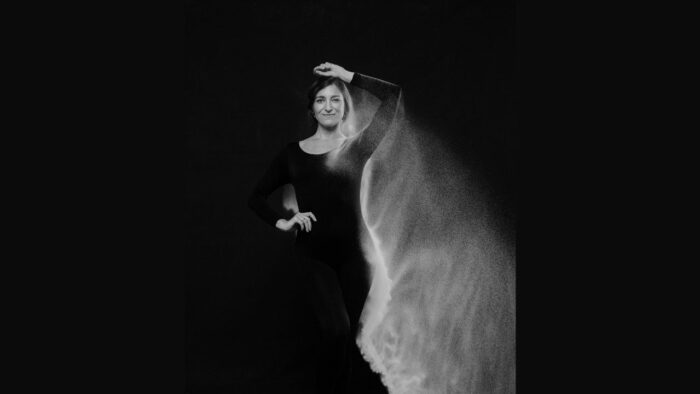Sand artist Anne Löper practises Veda recitation to invite Sarasvatī to inspire her and give her ideas, and she studies Vedānta for the clarity required to execute those ideas and turn them into art. In conversation with Veda Studies’ Sophie French…
When I started practising yoga and studying Indic knowledge systems, I did it as an outsider, as a non-Hindu, and the thing that drew me to Hindu spirituality was not so much God but rather the artistry with which the Hindus worship. When I explored spirituality through Sanātana Dharma’s art, I learned about the applied science of Śilpaśāstra and the Tālamāna system of aesthetic measurement and proportions that is applied to sculpting temple mūrtis. Indian temple art and architecture is quantitative and based on complex mathematical foundations. The language used to turn stone into a form of God comes from the Vedas, which in itself is “high-calibre poetry that was revealed to ancient Ṛṣis and Ṛṣikās in deep states of meditation,” says the founder of Veda Studies, Shantala Sriramaiahji.
It is no wonder then that any intellect that is inclined towards the arts or creativity will feel drawn towards Veda and this is exactly how Sand Artist, student of Vedanta and Veda Recitation teacher, Anne Löper, felt when she first heard Veda recitation at a temple in India. “When I heard Veda being recited, I was mesmerised. As an artist, I am sensitive to harmony and beauty, and I was moved to tears at that temple. Something inside me just knew I had to learn this,” recalls Anne about when she first felt inclined to learn and recite Veda.
Anne was born and raised in East Germany and feels her spiritual quality can be attributed to her grandmother, who was the only member of her atheist family that believed in God. “I think I got my grandmother’s spirit (laughs). I mean the world is so beautiful and there is such an intelligence in it. I knew there had to be more to creation than one God sitting in the sky, and if this God really was up there in the sky, then who created that God? Not that I have an issue with one God. For me, it was a matter of understanding who this God is and how this God came to be. This is also where Hinduism made sense to me. There are so many Gods, so many forces, so many elements so how can there only be one God. There are nuances and aspects to creation. But I also feel lucky that I came from an atheist family because that gave me a certain freedom of thought and it was easy for me to embrace dharma, and I also was blessed to meet the right teachers and mentors to shape my faith,” says Anne.
Turning Art into Sādhanā
Anne began her career as an illustrator and created artwork for children’s books, newspapers and magazines, but none of these mediums satisfied her creativity. She longed for more engagement with her audience and felt this kind of method of creating wasn’t interactive enough to fuel her creative inspiration. “Drawing for newspapers and magazines meant I didn’t even know who was looking at my work. I was seeking to do something more authentic and more in the moment because when you draw for newspapers and magazines, you make caricatures but you never see how people react. The art isn’t alive. I was literally praying to Ishvara to bring me something that suits my personality more and then I came across this Russian artist who does sand art and I knew immediately that this is what I was looking for where the end product is beautiful, yes, but also the process is so important. As an illustrator, I am trained to narrate through pictures, and sand art is the right medium for me. The most beautiful thing is that I can do this live with musicians. Before I found this, I was working in my room, on my bed and never met the people who would see the work I was doing. Now, I have a stage where I can express and demonstrate the stories I create with my art,” explains Anne.
In her sand art, she often depicts stories and scenes from the purāṇas and Veda recitation is also a major part of her artistic process. “Artists tend to be very involved with our moods and we’re always looking for the right mood in terms of motivation and inspiration. But we also have to be very stable and our mind has to be clear and receptive in order to create. Reciting Veda has refined my skill and my mind’s instrument. It has made me much more receptive and given me clarity. It has made me very sensitive to harmony because when you learn Veda recitation, you have to be very precise and your hearing gets very subtle and you learn to adjust to these harmonies. When you practise, there is also an effect on your being so there is a very tangible effect of Veda recitation on your being. There is also a level of grace that comes through prayer because you communicate with the deity. When I recite, I ask Sarasvatī, ‘give me inspiration, give me ideas and tell me how to draw and use shapes and forms,’ and I pray before I work. I think this really unleashes my creativity and makes my art so much more refined.”
Veda, Vedānta and the Art of Discipline
Spirituality has been a part of Anne’s consciousness from a young age. When I asked her how the spiritual path revealed itself to her she said, “I think on some level, it was always there. As an artist, I am always connected to this inner child and I always had the curiosity of a child and had questions like where did the universe come from? What is the cause of the universe? Who am I? While I was studying art, I also looked into philosophy. I read Schopenhauer and read Eastern and Western philosophy. I got into Buddhism and was always looking for answers to my questions but I was never satisfied till I found Indian scriptures. The moment I engaged with them, I really found answers. The seeker in me disappeared and these answers spoke to my mind. The methodology that the Ṛṣis came up with is so brilliant that I couldn’t argue with any of the knowledge that comes from the Vedas. When I started reciting Veda and studying with Shantala, I also made a connection between the scriptures that I had been reading and studying for years and the actual practice of reciting Veda — it is like the theoretical knowledge is transferred into actual practice. I found a way to put what I know into practice.”
Anne has also been practising hatha yoga for several years and while she feels it is a fantastic technique to keep the body instrument in good health her affinity is towards Jñāna yoga as she feels it embodies all aspects of spirituality. We’re both students of Veda and Vedānta and I was deeply pleased to share a mutual respect and admiration of the subtlety of Veda recitation with Anne. We agreed that Veda recitation is effective to move the mind from the gross to the subtle, “I feel Veda recitation really is among the most subtle practices and Vedānta really gives you a larger perspective. Vedānta helped me see beyond me. I don’t just see myself as, “Oh, I am Anne, I am an artist, etc.’ I am so much more. So that expansion of the vision of the Self that Vedānta gives you can really unleash creativity. That kind of inspiration transcends my mind’s limitation — it somehow makes me a free creator. Veda recitation brings up many old buried things like old emotional blocks that are stored deep inside us. I recite Veda for this reason. It really helps me unblock my emotions and slowly but steadily makes me more free with every practice. For an artist, that kind of freedom is so important. It allows you to create without limitation. For example, even in music, knowing a rāga is one thing, but to play with that rāga and take it to another level requires a certain clarity of intelligence and Veda recitation brings that clarity and freedom.”
Bhārata, You Beauty!
Anne’s first trip to India was in 2012 and her first experience in the country taught her an important lesson about the meaning of life which she discovered by watching how Indians celebrate death. “I got out of the airport and saw a crowd of people carrying a dead person and they were dancing and throwing flowers around and it looked like a celebration. In Germany, death is not celebrated, it is something that we hide and don’t acknowledge so openly. But watching this in India, I just felt that this is the proper thing to do. Death doesn’t have to be sad. At the time, I had no answers to this, but now I do. I know now that this is the proper way to deal with death. I also fell in love with India’s inescapable tastes and fragrances, it is so whole. India makes my soul dance. I never needed to adapt to India, I arrived and felt like I found a second home.”
I asked Anne what her advice would be to people coming to India to seek their Self. “As an artist or even as a spiritual aspirant, my advice would be when you go to India, look for authentic teachings and authentic traditions. Learn from people who are embedded into a tradition or a lineage. The most important thing to achieve is discipline and traditional teachings will train you for this. Discipline is more important than motivation. For example, in Western culture when I studied art, I was always told you have to be creative and focus on that, but I truly feel that the most important thing for an artist is discipline. Creativity is something that comes and goes and in order to tune into your creative element, you have to have the discipline to be there and be present when creativity comes. You can’t be moody and be like ‘Oh, I want to go for a walk,’ or do something else instead of working. You always have to be present and attentive to ideas when they come. That requires discipline. Sarasvatī is a diva, you know, she comes and goes as she pleases (laughs). So it is so important to be aware and attentive and present for her when she comes and that requires discipline and a fine tuning of the intellect so that when the grace of creativity comes, you are there to receive it.”
For further information or to follow Anne’s work, find her on @loperanne





